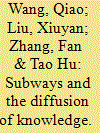| Srl | Item |
| 1 |
ID:
124228


|
|
|
|
|
| Publication |
2013.
|
| Summary/Abstract |
There is increasing attention for the contribution of emerging economies to global innovation, including innovation of renewable energy technologies. The Technological Innovation Systems (TIS) framework presents a list of system functions for the analysis of the development of a technology. It has often been applied to renewable energy technologies, but with a strong focus on advanced economies. In this paper, we elaborate on emerging economy innovation system formation, structured according to TIS functions. Rather than analysing development of the technology, we analyse the development of the Chinese TIS vis-à-vis the global forefront. Key to this notion is that TIS, especially for clean-tech, are transnational phenomena. Lagging TIS depend on the global TIS, whereas leading TIS contribute to its formation. It is concluded that China has reduced its dependence on foreign knowledge and investment, but the outward contribution remains limited. The main challenge to foreign market expansion lies in reforming the domestic TIS to focus on turbine quality rather than cost reduction. Demonstration projects are needed, especially for large capacity and offshore turbine models, in order to build up operational history and get quality certification.
|
|
|
|
|
|
|
|
|
|
|
|
|
|
|
|
| 2 |
ID:
161831


|
|
|
|
|
| Summary/Abstract |
Although infrastructure and innovation play important roles in fostering a country's economic growth, discussion in the literature about how the two are connected is limited. This paper examines the impact of road density on firm innovation in the People's Republic of China. The analysis uses a matched patent database at the firm level and road information at the city level. Regional variation in the difficulty of constructing roads is used as an instrumental variable to address the potential endogeneity problem of the road variable. The empirical results show that a 10% improvement in road density increases the average number of approved patents per firm by 0.71%. Road development spurs innovation by enlarging market size and facilitating knowledge spillover.
|
|
|
|
|
|
|
|
|
|
|
|
|
|
|
|
| 3 |
ID:
186951


|
|
|
|
|
| Summary/Abstract |
This paper aims to examine the role of the subway network, a typical form of transportation within urban areas, on innovation and knowledge diffusion. Applying the difference-in-differences strategy and spatial analysis, we used 1,332 newly opened stations in China from 2000 to 2013 as a quasi-experiment to identify the local effects of subway expansions. Results suggested that by reducing communication costs and increasing opportunities for interaction, subway construction would bring growth at the district level. Knowledge dissemination would become more active after new stations open. Micro-level results showed that these positive impacts were highly localized; that is, only those firms located within 1km around stations benefited from the new subway. Moreover, new subways facilitated the flow of knowledge from station to station and assisted firms in acquiring knowledge from more distant technology clusters conveniently.
|
|
|
|
|
|
|
|
|
|
|
|
|
|
|
|